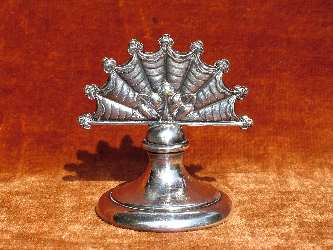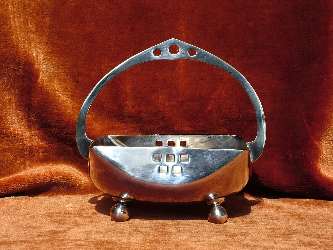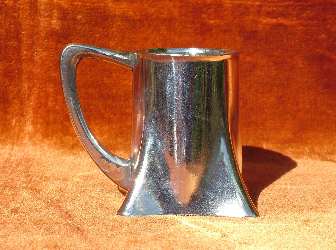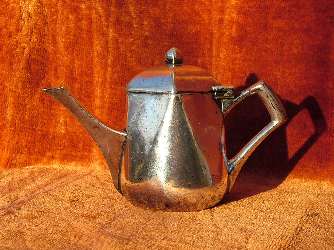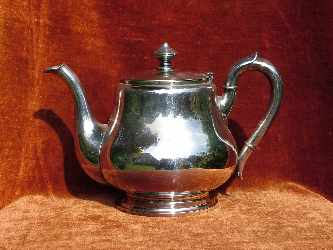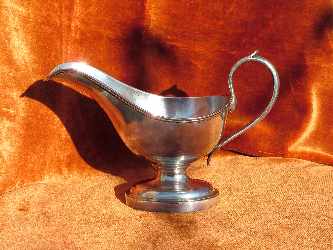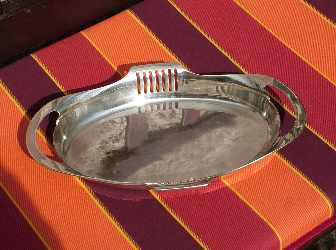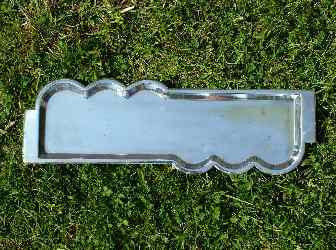by Prof.
David N. Nikogosyan, University College Cork, Cork, Ireland
if you like this page, support ASCAS clicking on the +1 button of google
(click on photos to enlarge image)
MARKS OF EUROPEAN SILVER PLATE:
IX. SZANDRIK, AUSTRO-HUNGARY / SANDRIK, CZECHOSLOVAKIA
In my previous article in ASCAS about Sandrik, due to wrong
information taken from the Slovak website, I made some mistakes,
which I am correcting now. In two words, this information
ignored completely the Hungarian origin of this company.
Actually, this silver production factory ("ezüstárúgyár" in
Hungarian) was built in the village of Alsó-Hámor, situated in
the Kingdom of Hungary, part of Austria-Hungary, and was
operating through the Hungarian capital. The name of this
Hungarian company was slightly different, not "Sandrik" but "Szandrik",
though both names phonetically sound similar as the combination
of the two letters "SZ" in Hungarian language corresponds to an
"S" in Slovak language.
After 1918 this place was included into the Czechoslovakian
state and was renamed Dolne Hámre and later became part of the
town Hodruša-Hámre in Czechoslovakia. Simultaneously, this firm
became Czechoslovakian and changed its name to "Sandrik". It was
in operation until the World War II. In 1993 Czechoslovakia was
split into the Czech Republic and Slovakia, and only in 1994
Sandrik was reopened as a Slovak firm. Now I will present a
slightly corrected version of the Szandrik/Sandrik company
history.
Silver-plated Szandrik pieces from my
collection: 1) (upper row, left) a menu holder; 2)
(upper row, right) a cake basket;
3) (bottom row, left) a milk can; 4) (bottom
row, right) a coffee pot, 20 cl., from Lipótvár
railway station
|
In 1752 the Dutch aristocrat Jan Joseph Geramb arrived in
Austria-Hungary to organise the mining business in which he was
very successful. At the end of the 18th century he founded the
Geramb Mining Union (Geramb Bergwerk Union or GBU in German),
which was the strongest and most profitable company in the whole
Austro-Hungarian monarchy. In the middle of the 19th century GBU
employed 1400 people and apart from the mining of common metals
(copper, lead, zinc), at the time of the highest prosperity, the
company annually extracted on average 28.3 kg of gold and 3,194
kg of silver. The prosperity of GBU lasted until the end of the
19th century.
Unfortunately, after the discovery of rich silver deposits in
South Africa and America, the world price of 1 kg decreased by
half. The deep mining used in the GBU didn’t allow the
extraction of the metal for a lower price. The mines and GBU
were about to become bankrupt. The businessman Rytier Robert von
Berks, a representative of GBU, decided to transform the
extracted metals into end products. In 1895 he founded a factory
for the processing of silver in Alsó-Hámor. He chose the land,
which belonged to Janos Szandrik. The company was given his name
after the land it had been built on. Berks chose as a graphic
trade mark the six-petal rose, which was adopted from the Geramb
coat of arms. According to the Berks project, the factory was
supposed to process 10,000 kg of silver per year.
In 1899, the designer and graduate of the Vienna Craft School,
Jan Peterka (1871-1938), started to work at Szandrik. According
to the conditions of the Budapest city government for providing
a financial loan, the factory was supposed to take part in the
World exhibition in Paris in 1900 with its own designed products.
Young Peterka fulfilled his task so successfully that the
objects designed by him were awarded a gold medal. For that
success, the 29 year-old Peterka was put in charge of the
factory. He stayed in this position until 1929. The factory was
active until World War II (from 1918 under the Sandrik name).
After World War II this company was nationalized and fused with
the Czechoslovakian firm Bibus.
Silver-plated Sandrik pieces from my
collection: 1) (upper row, left) a teapot, 150 cl.;
2) (upper row, right) a gravy boat, 28 cl.;
3) (bottom row, left) a fruit dish 4) (bottom row, right) a tray
|
In accordance with the two periods of this firm’s activity,
Hungarian and Czechoslovakian, we can divide all the marks for
silver-plated items into two groups. The first group contains
the name of the firm in Hungarian – "SZANDRIK" and two letters
"A" and "E", which I suppose means "Alpakka Ezüst", i.e.
"Alpacca Silber" in German or "Alpaca Silver" in English. The
second group contains the name of the firm in Czech/Slovak – "SANDRIK"
and two letters, "A" and "S", which I suppose means "Alpaka
Stríbro" in Czech or "Alpaka Striebro" in Slovak, i.e.
again "Alpacca Silber". It should be added that the name of the
animal alpaca is Alpakka in Hungarian and Alpaka in Czech/Slovak.
For one relatively rare mark, the German version of this name,
"Alpacca", was also used.
Below the revised list of the Szandrik/Sandrik marks, including
my latest findings, follows.
Szandrik marks (1895-1918)
|
N°
|
MARK
|
COMMENT
|
|
1
|
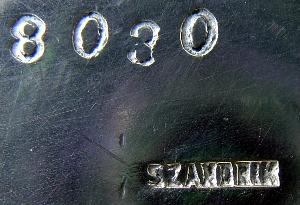


|
The first Szandrik mark consists of the simple
one-word inscription SZANDRIK, sometimes accompanied by
the model number. The length of the word SZANDRIK varies
between 5.6 and 7.0 mm, the ratio of the length of
SZANDRIK word to its height is 5.6.
|
|
2
|
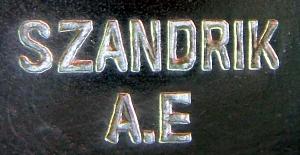
|
The second Szandrik mark consists of the inscription
SZANDRIK, accompanied by two letters, "A" and "E", which
is an abbreviation for Hungarian "Alpakka Ezüst", that
means silver-plated alpaca. The length of the word
SZANDRIK is 9.4 mm, while the ratio of the length of
SZANDRIK word to its height is 5.0.
|
|
3
|
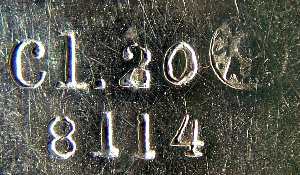
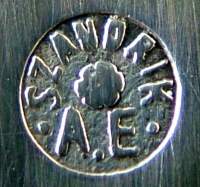
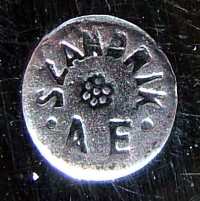
|
The third and most common Szandrik mark
consists of the previous inscription SZANDRIK AE, placed
inside a circle together with a six-petal rose. Often
it is accompanied by the model number and/or the volume
mark (if any). The diameter of the circle varies between
3.4 and 3.9 mm.
|
|
4
|
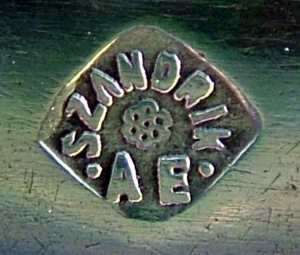
|
The last Szandrik mark consists of the inscription
SZANDRIK AE, placed inside a rhombus together with a
six-petal rose. By analogy with the mark used at the same
time by the famous Arthur Krupp metalware factory in
Berndorf, Austria-Hungary, it should be related to a
low-quality silver plate. The size of the rhombus varies
between 3.3 mm x 3.7 mm and 3.7 mm x 4.0 mm.
|
Sandrik marks (1918-c.1940)
|
N°
|
MARK
|
COMMENT
|
|
5
|
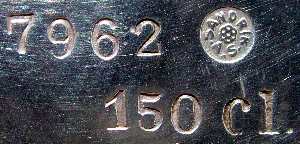
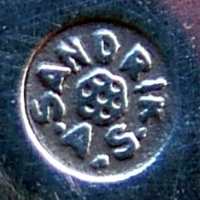
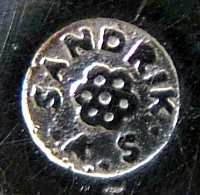
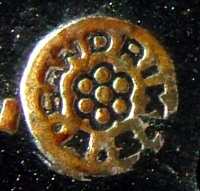
|
The most common Sandrik mark, which was derived from
the Szandrik mark No.3 by changing the inscription
SZANDRIK AE for a new one, SANDRIK AS. The two letters,
"A" and "S", mean "Alpaka
Stríbro" in Czech or "Alpaka Striebro" in Slovak
(again silver-plated alpaca in English). This mark is
often accompanied by the model number and/or the
volume mark (if any). Note that there are some
variations in size and form of the six-petal rose inside
the circle. The diameter of the circle is between 3.2
and 3.9 mm.
|
|
6
|

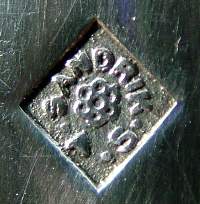
|
The next Sandrik mark again was derived from similar
Szandrik mark No.4. Again it refers to a low-quality
silver plate. The size of the rhombus varies between 4.5
mm x 4.5 mm and 5.1 mm x 5.1 mm.
|
|
7
|
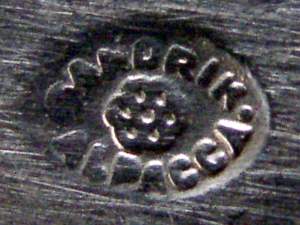
|
The original Sandrik mark, which was created
probably to mark the products made for export. This
explains the use of German word ALPACCA. The size of the
oval is 4.3 mm x 5.4 mm.
|
|
8
|
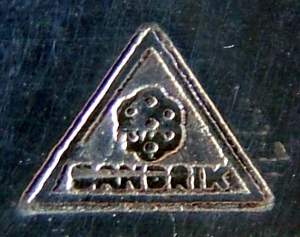
|
The next original Sandrik mark was invented in the
thirties to mark the flatware products and trays. The
mark size is 3.4 mm (height) x 4.7 mm (base).
|
LITERATURE
1. David N. Nikogosyan, Marks of European Silver Plate: I.
Sandrik, Slovakia,
http://www.ascasonline.org/windowOTTOB53.html
2. Súkromná stredná odborná škola umeleckoremeselná
Hodruša-Hámre (Private secondary crafts school in Hodruša-Hámre),
http://www.ssushh.sk/sou/sou_index.php?menu=s_skola&content=sou_historia,
in Slovak.
3. Dedo von Kerssenbrock-Krosigk and Claudia Kanowski: Modern
Art of Metallwork (Berlin: Bröhan Museum, 2001), pp. 552, 555.
The author is grateful to his wife Danielle for her invaluable
help with Hungarian translations.
Prof. David N. Nikogosyan,
University College Cork, Cork, Ireland
- 2011 -
|
|
|

